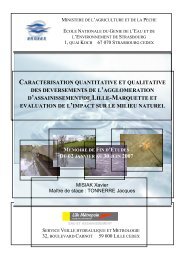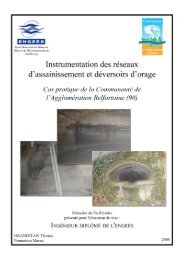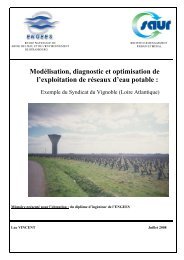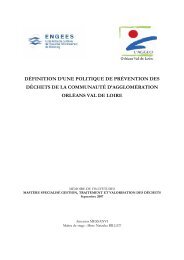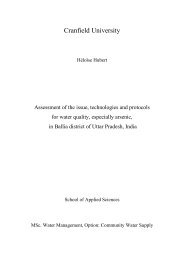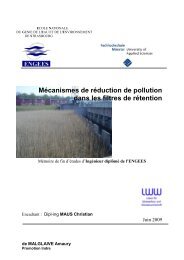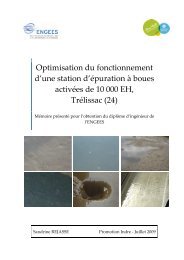Evaluation of water supply system Case study in Naka ... - ENGEES
Evaluation of water supply system Case study in Naka ... - ENGEES
Evaluation of water supply system Case study in Naka ... - ENGEES
- No tags were found...
Create successful ePaper yourself
Turn your PDF publications into a flip-book with our unique Google optimized e-Paper software.
<strong>Evaluation</strong> <strong>of</strong> <strong>water</strong> <strong>supply</strong> <strong>system</strong> – <strong>Case</strong> <strong>study</strong> <strong>in</strong> <strong>Naka</strong>, NigeriaHowever, consider<strong>in</strong>g the importance <strong>of</strong> susta<strong>in</strong>ability for the success <strong>of</strong> <strong>water</strong> <strong>supply</strong>,it was not considered appropriate to expand a <strong>system</strong> which was not actuallyprovid<strong>in</strong>g a basic satisfactory level <strong>of</strong> services: cont<strong>in</strong>uous, regular, durable, goodquality and with equity. At that time, the <strong>system</strong> was not fulfill<strong>in</strong>g any <strong>of</strong> these criteriaso that any addition <strong>of</strong> connection would make the service quality worse, especiallyfor the pressure delivered at tap. That was ma<strong>in</strong>ly due to the physical <strong>in</strong>capacity <strong>of</strong> theassets to deal with 100 taps connections whereas the <strong>system</strong> was <strong>in</strong>itially designed for15 taps, lead<strong>in</strong>g to accrued problems <strong>of</strong> pressure. Therefore <strong>in</strong>equity <strong>in</strong>creasedbecause the connections added closer to the over-head tank had greater advantagesthan taps at other location. The fact that the <strong>system</strong> was even not work<strong>in</strong>g at the rate itwas designed for (7m 3 /h <strong>in</strong>stead <strong>of</strong> 20m 3 /h) weighed <strong>in</strong> the favour <strong>of</strong> refus<strong>in</strong>g theexpansion for the moment and rather to look deeply at the current <strong>system</strong> <strong>in</strong> order tomake it work <strong>in</strong> an optimum and susta<strong>in</strong>able manner. As the generator had just beenrepaired, that would improve the quality <strong>of</strong> services, on condition that the <strong>supply</strong> <strong>of</strong>fuel is reliable <strong>in</strong> terms <strong>of</strong> frequency, quantity and quality.The requirements from community members also related to an <strong>in</strong>crease <strong>of</strong> the <strong>in</strong>takepump<strong>in</strong>g rate and an expansion <strong>of</strong> the exist<strong>in</strong>g dam. Increase <strong>of</strong> pump<strong>in</strong>g rate morethan 20m 3 /h may first disturb the treatment process; then capacity <strong>of</strong> recharge <strong>of</strong> thedam need to be known because there is no po<strong>in</strong>t endanger<strong>in</strong>g the susta<strong>in</strong>ability <strong>of</strong> the<strong>water</strong> resource. Nevertheless, these were options to <strong>study</strong> later on, when the <strong>system</strong>would be ready for expansion and after acknowledgment <strong>of</strong> the present concerns.Cranfield University at Silsoe 30 Florianne Bourrigault (2006)




